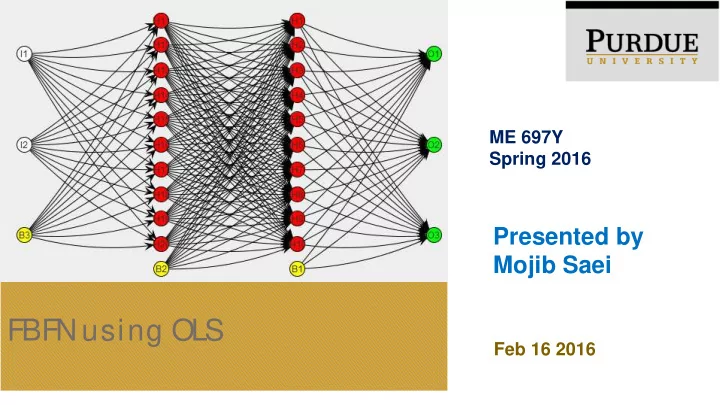

ME 697Y Spring 2016 Presented by Mojib Saei FBFN using OLS Feb 16 2016
Problem Definition • 2 input, single output function used for HW#2 • 2 input, single output function from OLS RBFN − + − − − + − + = + 2 2 − + 2 2 ( 0.5) (x 0.5) ( 1.5) (x 1) x x 6*sin(1.1 ) 10*cos(0.5 ) 2 1 2 1 y e e + − − − + + − − − − 2 2 2 2 4*( 1.5) (x 1) ( 0.5) (x 2) 1.5* x 1.5* x 1 2 1 2 e e − ≤ ≤ − ≤ ≤ 4 4, 4 4 x x 1 2 2
Methodology Fundamental Difference with RBFN For Example: Li-Xin Wang and Jerry M. Mendel, “Fuzzy Basis Functions, Universal Approximation, and Orthogonal Least-Squares Learning”, IEEE, VOL. 3, NO. 5, 1992 3
Methodology Here σ is fixed to 0.5 for all the Does it make a difference? calculations (RBFN, FBFN) • The summation in the denumerator is for all the hidden nodes • At the beginning of OLD: P is evaluated assuming each data point is a potential hidden node • If data points are concentrated in a region, it is possible to get higher P value (in the order of 1000) for some regions and zero for far regions Evaluated for the region with high Evaluated for the region with lower concentration of data points concentration of data points 4
Training Results RBFN FBFN First Function Second Function 5
Test Results First Function FBFN RBFN # nodes=30 6
Test Results Second FBFN RBFN Function # nodes=30 # nodes=50 7
Graphical Approximation • For all previously shown data: a grid of [-3:0.1:3]*[-3:0.1:3] is used for training data for first function a grid of [-4:0.1:4]*[-4:0.1:4] is used for training data for first function • To investigate sensitivity of method to the training data → 2000 random data points is added to the grids mentioned in the previous slide → so number of training points is increased by: 35% for the first function 23% for the second function 8
Test Results FBFN RBFN 2nd run 1st run # nodes=30 4th run 3rd run 9
Test Results FBFN RBFN 2nd run 1st run 3rd run 4th run # nodes=50 10
Conclusion • Chosen system is too small to show the real power of FBFN • It has been shown that OLS method for FBFN should be done with care in regard to the choice of training data (which was the source of error in my first presentation) • The summation in the denumerator of P function is the source of this issue • Overall RBFN and FBFN demonstrate the same performance To check the results (for the case of 2000 data points added): Use RBFNcheck7.m and FBFNcheck7.m 11
Recommend
More recommend